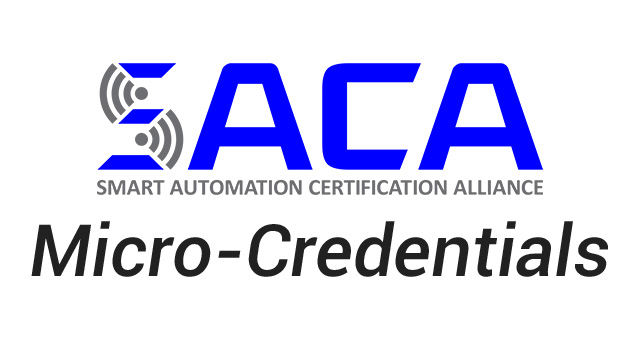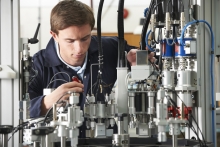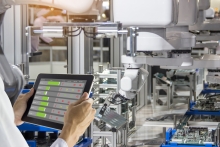SACA Micro-Credentials
SACA's Micro-Credentials can be attained to prove efficiency in specific applications or combined to attain a full SACA Specialist Certification.
C-201 Electrical Systems 1
Prepares individuals to connect, adjust, operate, troubleshoot, and analyze electrical circuits using basic electrical components: resistors, capacitors, inductors, DC motors, solenoids, manual switches, relays, fuses, circuit breakers, transformers, and indicators. Other key skills include: adhering to electrical safety rules, reading electrical circuit diagrams, applying Ohm’s Law and Kirchoff’s Law, using digital multimeters, interpreting series/parallel circuits, and assessing power/circuit protection.
C-202 Electric Motor Control Systems 1
Prepares individuals to connect, adjust, and operate electrical motor control circuits using these electrical components: 3-phase AC motors, reversing magnetic motor starters with overloads, drum switches, control relays, timer relays, pushbutton switches, selector switches, limit switches, pressure switches, and float switches. Other key skills include: adhering to motor control safety rules, reading ladder logic circuit diagrams, checking for proper ground connections, wiring motors for high and low voltage, and interpreting common motor control application circuits.
C-203 Variable Frequency Drive Systems 1
Prepares individuals to connect, configure, adjust, and operate AC variable frequency motor drives using basic volts per hertz mode. Key skills include: adhering to VFD safety rules, operating VFD in manual using keypad, performing normal VFD startup and shutdown, performing emergency shutdown, viewing and editing parameters, changing speed with potentiometer, interfacing/configurating external discrete I/O, interpreting error codes, resetting drive errors, and configurating for acceleration, deceleration and braking.
C-204 Motor Control Troubleshooting 1
Prepares individuals to troubleshoot and remedy faults in electric motor control circuits and AC variable frequency drives. Skills include: adhering to troubleshooting safety rules, systems troubleshooting, component testing, and using digital multimeters, clamp-on ammeters, and PLC status indicators. Components include: AC VFD drives with volts per hertz capability, 3-phase AC motors, reversing magnetic motor starters with overloads, drum switches, control relays, timer relays, manual switches, limit switches, pressure switches, and float switches.
C-205 Sensor Logic Systems 1
Prepares individuals to connect, adjust, and operate discrete (on/off) electronic sensors and relay control sequence circuits using these components: inductive sensors, capacitive sensors, magnetic reed sensors, photoelectric sensors, hall effect sensors, limit switches, control relays, timer relays, manual switches, DC motors, indicators, electro-pneumatic solenoid directional control valves, and pneumatic actuators. Other key skills include: selecting sensor type for an application, reading ladder logic circuit diagrams, and interpreting common relay-control sequence applications circuits.
C-206 Electrical System Installation 1
Prepares individuals to install and test/commission electrical motor control circuits using these electrical components: control cabinet enclosures, 3-phase AC motors, reversing magnetic motor starters with overloads, control relays, timer relays, pushbutton switches, selector switches, limit switches, pressure switches, indicators, electro-pneumatic solenoid valves, safety disconnect switches, and circuit protection. Key skills include: adhering to motor control installation safety rules, using proper PPE, reading electrical wiring installation diagrams, sizing circuit protection, installing components on DIN rails and cabinet panels, installing and testing ground systems, wiring motors for high and low voltage, selecting and preparing wire for installation, attaching of wire to terminal strips and components/motors, and routing of wire with raceways/conduits
C-207 Programmable Controller Systems 1
Prepares individuals to program, configuration, adjust, monitor, and operate industrial programmable logic controller (PLC) systems. Key skills include: adhering to PLC safety rules, performing normal startup/shutdown, operating PLC in different modes, performing emergency shutdown and reset, monitoring for proper operation through indicators and PC-based PLC software, configuring processor software drivers for communication to PC, configuring and loading of HMI programs, operating HMI with PLC, configuring PLC discrete I/O, transferring programs between PC and PLC processor, interpreting basic and intermediate level PLC ladder logic programs (with contacts, coils, timers, counters, math, comparison instructions), PLC project creation/editing, and interpreting common PLC program logic applications using electro-pneumatic actuators and on/off motor control systems.
C-208 Programmable Controller Troubleshooting 1
Prepares individuals to troubleshoot and remedy faults in programmable logic controller systems. Skills include: systems troubleshooting and component testing using digital multimeters, PLC software, and PLC status indicators. Components include: PLC power supply, power distribution system, processor module, discrete input and output modules, chassis, and discrete field I/O devices. Troubleshooting applications include: multi-step machine sequence logic programs using electro-pneumatic actuators and on/off motor control systems.
C-209 Pneumatic Systems 1
Prepares individuals to connect, adjust, operate, and analyze pneumatic circuits using these components: quick connect fittings, tee and cross fittings, air compressors, filters, regulators, lubricators, gauges, rotameters, directional control valves, flow control valves, check valves, cylinders, and motors. Other key skills include: adhering to pneumatic safety rules, reading pneumatic circuit symbols and diagrams, applying the Force-Pressure-Area formula, converting absolute/gauge pressure units, performing reciprocating compressor startup/shutdown, applying Pascal’s Law, setting pressure switch, filter draining, setting lubricator rate, lubricator refilling, and measuring delta P.
C-210 Mechanical Power Systems I
Prepares individuals to install, adjust, align, tension, operate and analyze basic mechanical power transmission drive systems using these components: motors, shafts, flexible jaw couplings, fractional horsepower (FHP) chain drives, FHP v-belt drives, spur gear drives, pillow block bearings, and flange bearings. Other key skills include: adhering to mechanical drive safety rules, mounting and leveling motors, testing and correcting for soft foot, installing components and shafts with keyways, sizing keys, aligning shafts using feeler gage and straight edge method, calculating speed and torque from component size ratios, interpreting rotary power specifications, determining mechanical efficiency, greasing bearings using a grease gun, refilling oil lubrication reservoirs, interpreting lubrication specifications, and identifying component given a model number.
C-211 Industry 4.0 Total Productive Maintenance
Prepares individuals to perform maintenance in a production environment where Industry 4.0 technology is used. Key skills include: interpreting maintenance work orders, receiving/responding to maintenance work orders via mobile/cloud technology, using a cloud-based maintenance management system to maintain and analyze process or machine history, performing preventive maintenance schedule with electronic record keeping, cleaning machines, lubricating and adjusting machines, calculating overall equipment effectiveness (OEE) and machine downtime, identifying methods of reducing downtime, and using basic troubleshooting methodologies to find root causes.
C-212 Ethernet Communications 1
Prepares individuals to connect, configure, monitor, and operate basic Ethernet networks in an Industry 4.0 environment. Key skills include: interpreting IP addresses, setting IP addresses (PCs, PLCs, robots, and other machines), connecting devices to an Ethernet network, setting up and configuring a basic managed Ethernet switch that uses layer 2 technology, connecting an Ethernet network in a star topology, configuring a managed switch subnet, identifying type of topology given a diagram, configuring a network for static and dynamic addressing, monitoring and interpreting status indicators on switch, viewing managed Ethernet switch network performance and diagnostics via software, and configuring port security of a managed switch network.
C-213 Smart Sensor and Identification Systems 1
Prepares individuals to connect, configure, adjust, program, monitor, and operate smart sensors (analog pressure/ultrasonic, photoelectric, and stack light), barcode readers, and RFID readers in an Industry 4.0 environment. Key skills include: connecting sensors to Ethernet network through IO-Link Masters or directly, configuring IO-Link Masters, interpreting sensor and IO-Link Master status indicators, downloading IODD and EDS files for smart sensors, wiring smart sensors, configuring PLCs to receive data from smart sensors through network, monitoring health of sensors through network, programming RFID tags or printing barcode labels, setting up and operating RFID readers, configuring RFID/barcode readers to communicate to a PLC, configuring Ethernet-serial converter to communicate sensor data to PLCs, and programming PLCs to use smart sensor/RFID/barcode data to perform common process applications.
C-214 Smart Factory Systems 1
Prepares individuals to set up, adjust, configure, program, interface, monitor, and operate smart factory systems that use Industry 4.0 technology to efficiently produce high-quality products in these applications as an integrated system: pick and place, gauging, indexing, sorting and queuing, and robotic assembly. Components used shall include: DC-motor belt conveyors, ball screw linear drives, electro-pneumatic actuators/valves, vacuum parts pickup, vacuum switches, electronic sensors, clutch, stepper motors, and servo robots. Other key skills include: adhering to smart factory safety rules, configuring and interfacing PLC and robot controllers via Ethernet/IP and discrete I/O handshaking, using Ethernet message instruction to perform controller-to-controller handshaking, and programming/operating a multi-station production process.
C-215 Robot System Operations 1
Prepares individuals to set up, adjust, monitor and operate industrial robot systems in an Industry 4.0 automation environment. Key skills include: adhering to robot safety rules, identifying robot types and robot components (and end-effectors), performing normal startup and shutdown, performing emergency shutdown and recovery, identifying robot work envelope, performing robot safety inspection, using teach pendant to view menus and status indicators, using teach pendant to jog robot in joint mode or using Cartesian coordinates, adjusting jog speed, setting and testing robot joint travel limits, using teach pendant to identify robot position in each of 5 frames, defining a frame using 3-point method, loading a robot program using Ethernet or memory card, testing digital robot inputs and outputs, testing robot program in single step or continuous mode, selecting and running robot program using teach pendant, teaching/adjusting robot points using proper frame, identifying/recovering from a fault, and viewing/interpreting robot alarm history.
C-216 Robot Systems Integration 1
Prepares individuals to program, interface, and optimize industrial robot systems in an Industry 4.0 automation environment for these applications: pick and place, basic assembly, machine load/unload, and gluing. Key skills include: interpreting robot programs, developing robot sequence operations and robot program for an application, entering robot programs and points using a teach pendant, interfacing on/off input sensors and solenoid output devices to digital I/O of robot, interfacing digital I/O of robot to PLC, and cycle time optimization. Programs commands include: 3 types of motion, speed, offset, data register, branching, digital I/O, looping, waiting, and macros.
C-255 Hydraulic Systems 1
Prepares individuals to connect, adjust, operate, and analyze hydraulic circuits using these components: quick connect fittings, tee and cross fittings, fixed displacement pumps, filters, pilot-operated and direct operated relief valves, gauges, flow meters, directional control valves, flow control valves, check valves, pressure reducing valves, sequence valves, accumulators, pressure compensated flow control valves, cylinders, and motors. Other key skills include: adhering to hydraulic safety rules, reading hydraulic circuit symbols and diagrams, applying the Force-Pressure-Area formula, converting absolute/gauge pressure units, performing hydraulic power unit startup/shutdown, applying Pascal’s Law, charging accumulators, reservoir refilling, and measuring delta P.
C-256 Hydraulic Maintenance 1
Prepares individuals to install and maintain hydraulic systems. Skills include: adhering to hydraulic maintenance safety rules, replacing o-rings, replacing subplate-mounted/cartridge/threaded components, replacing hoses and steel tubing, replacing spin-on and cartridge filters, replacing hydraulic fittings, inspecting hydraulic fluid visually for presence of water or contaminants, inspecting hydraulic fluid using feel/smell for excess temperature and lubricity, taking oil samples for lab testing, using a filter cart to clean a reservoir oil, using a filter cart to change or add reservoir oil, interpreting oil specifications, identifying proper oil container using machine manufacturer specifications, identifying hydraulic components given a specification, and bleeding hydraulic cylinders.
C-257 Process Control Systems 1
Prepares individuals to connect, program, adjust/tune, calibrate, and operate open loop, closed loop, and on/off industrial process control systems controlling liquid flow and liquid level. Other key skills include: adhering to process control safety rules, reading process and instrumentation (P&ID) diagrams, interpreting instrument data given an instrument index, interpreting instrument tags, and performing startup/shutdown. Components include: PID controllers, 2-way pneumatic proportional control valves, I/P converters, level sight glasses, centrifugal pumps, manual valves, solenoid valves, control relays, analog pressure-type liquid level sensor, paddlewheel flow sensor, flow transmitter, and process meters.
C-258 Process Control Troubleshooting 1
Prepares individuals to troubleshoot and remedy faults in open loop, closed loop, and on/off industrial process control systems controlling liquid flow and liquid level. Skills include: systems troubleshooting and component testing using digital multimeters, status indicators, and controller screen display. Components include: PID controllers, 2-way pneumatic proportional control valves, I/P converters, level sight glasses, centrifugal pumps, manual valves, solenoid valves, control relays, analog pressure-type liquid level sensor, paddlewheel flow sensor, flow transmitter, and process meters.
C-259 Rigging Systems 1
Prepares individuals to select, size, assemble, adjust, and use rigging apparatus to lift, move or transport a load. Elements used include: hooks and eyebolts, shackles, manual hoists, powered hoists, slings and hitches, basket slings, choker sling, bridle sling, spreader beams, wire rope slings, and chain slings. Other key skills include: adhering to rigging safety rules, identifying rigging components given a part number, calculating load weight and balance, determining center of gravity, calculating rated load of hitches, and calculating crush force.
C-260 Rigging Systems 2
Prepares individuals to select, size, assemble, adjust, and use rigging apparatus to lift, move or transport a load. In addition to those elements used in Rigging Systems 1, other elements include: synthetic slings, pry trucks, dollies, pry bars and rollers, and hydraulic jacks. Other key skills include: adhering to equipment movement safety rules, identifying synthetic sling types given a part number, identifying crane types, and using crane hand signals.
C-301 Mechanical Power Systems 2
Prepares individuals to install, adjust, align, tension, operate, troubleshoot, maintain, and analyze heavy duty mechanical power transmission drive systems using these components: motors, shafts, gear/grid/flange couplings, QD/taper lock/split taper bushings, multiple belt/timing/HTD belt drives, and heavy duty/silent chain drives. Other key skills include: adhering to mechanical drive troubleshooting safety rules, performing reverse dial indicator shaft alignment, identifying components given a model number, selecting/sizing components for a given application, and identifying/correcting component wear.
C-302 Laser Shaft Alignment 1
Prepares individuals to install, configure, adjust, and operate laser shaft alignment systems to perform precision alignment of mechanical power transmission shafts. Other key skills include: adhering to laser system safety rules, using jackbolts for rough alignments, using laser system to correct for soft foot, and determining proper alignment tolerances from manufacturer’s documentation.
C-303 Electric Motor Troubleshooting 1
Prepares individuals to troubleshoot and remedy faults in AC and DC electric motors. Skills include: adhering to troubleshooting safety rules, systems troubleshooting, component testing, and using digital multimeters, clamp-on ammeters, and megohmmeter. Motors include: series/compound/shunt DC motors, dual voltage/wye/delta 3-phase AC motors, and capacitor start/permanent/start-run/split phase single-phase AC motors. Other key skills: measuring motor speed/torque/power, doing root cause failure analysis.
C-304 Pneumatic Troubleshooting 1
Prepares individuals to troubleshoot and remedy faults in electro-pneumatic PLC-controlled systems. Skills include adhering to troubleshooting safety rules, systems troubleshooting, component testing, and using digital multimeters and status indicators. Components include: filters, regulators, lubricators, solenoid-operated directional control valves, flow control valves, vacuum generators, vacuum cups, vacuum switches, quick exhaust valves, limit switches, electronic sensors, PLC I/O modules, check valves, cylinders, and motors.
C-305 Industrial Electronic Systems 1
Prepares individuals to connect, adjust, operate, and troubleshoot industrial electronic linear DC power supplies, discrete input devices, and analog input devices. Troubleshooting skills include: adhering to electronic troubleshooting safety rules, reading electronic circuit diagrams, systems troubleshooting, component testing, and using digital multimeters, oscilloscopes, and status indicators. Components include: diodes, rectification circuits, Wheatstone bridge circuits, filter circuits, regulators, BJT transistors, PNP and NPN relays, analog temperature sensors, analog pressure sensors, analog proximity sensors, and signal conditioner circuits.
C-306 Industrial Electronic Systems 2
Prepares individuals to connect, adjust, operate, and troubleshoot industrial electronic switching circuits used for motor control, switching power supplies and heating. Troubleshooting skills include: systems troubleshooting, component testing, and using digital multimeters, oscilloscopes, and status indicators. Components: FET/JFET/MOSFET/IGBT transistors, PWM amplifiers, switching DC power supplies, variable frequency amplifier circuits, operational amplifiers, SCR DC motor control switching circuits, and TRIAC AC motor control and heating switching circuits.
C-307 Electronic Systems Installation 1
Prepares individuals to install and test/commission industrial electrical control systems that incorporate programmable logic controllers (PLC), human machine interface (HMI) panels, and variable frequency AC drives (VFD). Key skills include: adhering to electronic installation safety rules, using proper PPE, reading wiring installation diagrams with PLCs/HMIs/VFDs; cabinet mounting PLCs/HMIs/VFDs, wire routing and grounding PLCs/HMIs/VFDs, soldering/de-soldering to component terminals and printed circuit boards, installing Modbus and Ethernet communications network, and installing analog input transmitters and analog sensors.
C-308 Variable Frequency Drive Systems 2
Prepares individuals to connect, configure, adjust, operate, and troubleshoot advanced AC variable frequency motor drives using sensorless vector and flux vector modes. Key skills include: configuring control mode, encoder interface and troubleshooting, configuring external speed control, configuring torque control, monitoring and configuring PC-based drive software, configuring USB and Ethernet communications, and configuring/programming VFD communications with programmable logic controller.
C-309 Programmable Controller Systems 2
Prepares individuals to connect, configure, program, adjust, operate, and troubleshoot programmable logic controller (PLC) systems that use analog I/O and human machine interface panels (HMIs). Key skills include: interface analog modules to inputs and outputs that use voltage and current signals, configuring analog I/O modules, interpreting logic programs that use analog I/O, interpreting program control instructions (MCR, jump/label, subroutine, program initialization), and creating HMI programs (with screen navigation, dynamic discrete and numeric objects, dynamic graphics, and information/alarm/diagnostic messages).
C-310 Ethernet Communications 2
Prepares individuals to connect, configure, monitor, operate, and troubleshoot Ethernet networks using wireless communications, ring/star topology, and layer 3 managed Ethernet switches. Other key skills include: configuring VLAN, configuring managed switch security, and programming/interpreting PLC-to-PLC data communications via Ethernet/IP.
C-311 Data Analytics 1
Prepares individuals to program, configure, monitor, and operate cloud-based data analytics and Supervisory Control and Data Acquisition (SCADA) software systems in an Industry 4.0 environment. Key skills include: configuring production statistics collection from PLCs and other controllers via Ethernet networks, configuring production statistics and alarm dashboard display, OPC server configuration/interfacing to control devices, configuring maintenance management application, configuring alarm screen, configuring SQL database for storage of data from SCADA software, developing queries to SQL database to display data, and analyzing data to optimize systems.
C-312 Robot Systems Integration 2
Prepares individuals to program, interface, and troubleshoot industrial robot systems in an Industry 4.0 automation environment. Key skills include: interfacing analog I/O to robot, communicating I/O control data to/from a PLC via Ethernet/IP network, vision guidance, and vision inspection. Programs commands include: group I/O, position offset, position register, analog I/O, Ethernet handshaking, end-effector macro, robot system troubleshooting, and alarm screen interpretation.
C-313 Smart Factory Systems 2
Prepares individuals to perform set up, adjust, configure, program, interface, monitor, and operate smart factory systems which use Industry 4.0 technology to efficiently produce high-quality products in these applications as an integrated system: torque control and testing, product pressure testing, and automated parts storage. Components used shall include: cloud-based manufacturing execution software, multiple PLCs, DC motors, IO-link current sensor, IO-link analog pressure sensor, IO-link analog position sensor, and linear pneumatic actuators. Other key skills include: using MES software for production management, configuring/using HMI order entry screens, monitoring and control of process from cloud using mobile devices, and programming PLC logic programs for Ethernet communications between PLCs.
C-351 Predictive Maintenance 1
Prepares individuals to perform predictive maintenance using vibration monitoring and analysis techniques. Key skills include: identifying suitable vibration applications, determining the frequency and amplitude of a harmonic vibration given measurement data, using a hand-held vibration meter to take vibration readings, mounting and connecting vibration sensors, selecting proper location for vibration sensor mounting, and analyzing machine vibration data using severity charts and other methods. Applications include: bearings, belt/chain drives, and rotating shafts.
C-352 Mechanical Power Systems 3
Prepares individuals to install, adjust, align, tension, operate, troubleshoot, and maintain mechanical power transmission drive systems using these components: motors, shafts, plain bearings, ball bearings, taper roller bearings, duplex angular contact bearings, gaskets, o-rings, lip seals, mechanical seals, helical gears, worm gears, right angle bevel gears, and gearboxes. Bearing installation skills include using: mandrels/hammers, bearing pullers, arbor presses, bearing heaters, temperature crayons, and grease/oil lubrication.
C-353 Mechanical Power Systems 4
Prepares individuals to install, adjust, align, tension, operate, troubleshoot, and maintain mechanical power transmission drive systems using these components: motors, shafts, electro-magnetic brakes, linear ball bearings, ball screw drives, friction clutches, and cam clutches.
C-354 Hydraulic Systems 2
Prepares individuals to connect, adjust, operate, and analyze heavy duty industrial hydraulic circuits using these components: 2-stage directional control valves, subplate-mounted pressure and flow control valves, pressure-compensated variable volume pumps, cylinders cushions, counterbalance valves, and unloader valves.
C-355 Hydraulics Troubleshooting 1
Prepares individuals to troubleshoot and remedy faults in electro-hydraulic PLC-controlled systems. Skills include: adhering to troubleshooting safety rules, systems troubleshooting, component testing, and using digital multimeters and status indicators. Components include: fixed displacement pumps, filters, relief valves, pressure reducing valves, solenoid-operated directional control valves, needle valves, flow control valves, limit switches, electronic sensors, PLC I/O modules, check valves, cylinders, and motors.
C-356 Process Control Systems 2
Prepares individuals to connect, program, adjust/tune, calibrate, and operate open loop, closed loop, and on/off industrial process control systems controlling temperature. Other key skills include: adhering to process control safety rules, reading process and instrumentation (P&ID) diagrams, interpreting instrument data given an instrument index, interpreting instrument tags, and performing startup/shutdown. Components include: PID controllers, 3-way pneumatic proportional control valves, I/P converters, temperature gages, centrifugal pumps, manual valves, solenoid valves, control relays, thermocouples, RTD temperature sensors, thermistors, temperature transmitters, and process meters.
C-358 Autonomous Mobile Robot Systems 1
Prepares individuals to program, adjust, monitor and operate industrial autonomous mobile robot (AMR) systems. Key skills include: adhering to AMR safety rules, performing normal startup/shutdown, performing emergency shutdown and reset, operating AMR in manual and automatic modes, charging batteries, using PC-based software, programming missions with logic and I/O, mapping workspaces (zones, positions, markers), configuring WIFI communications, and analyzing and remedying faults.
C-359 Programmable Controller Systems 3
Prepares individuals to connect, configure, program, adjust, monitor, and operate programmable logic controller (PLC) systems that use distributed I/O via Ethernet, serial data communications, Modbus communication protocol, high speed counters with encoders, and Statement List programming language. Other key skills include: interpreting PLC programs with PID instructions, data arrays, string data, and data conversion instructions.
C-360 Motion Control Systems 1
Prepares individuals to program, configure, adjust, monitor, and operate industrial motion control systems that perform single-axis closed loop position and velocity control of actuators. Key skills include: adhering to motion control safety rules, performing normal startup/shutdown, operating motion control system in closed and open loop modes, performing emergency shutdown and reset, monitoring for proper operation through indicators and PC-based software, configuring for communication to PC via Ethernet, transferring programs, configuring for motor drives and limit sensors/encoders, and interpreting logic programs.
C-361 Programmable Conveyor Systems 1
Prepares individuals to program, configure, adjust, monitor, and operate asynchronous pallet transfer conveyor systems that use RFID pallet tracking, Ethernet communications and PLC control. Key skills include: adhering to conveyor safety rules, performing normal startup/shutdown, operating conveyor system in manual and automatic, performing emergency shutdown and reset, monitoring for proper operation through indicators and PC-based software, developing/interpreting PLC logic programs that control conveyor sequences, using HMI programs to operate conveyor, and testing/commissioning conveyor systems.
C-362 Machine Vision Systems 1
Prepares individuals to program, configure, adjust, monitor, and operate 2D black and white machine vision systems used for parts inspection. Key skills include: performing normal startup/shutdown, adjusting lighting and camera, configuring vision parameters, programming system for part presence/features/dimensions, and programming Ethernet and discrete I/O communications to automation controllers.







